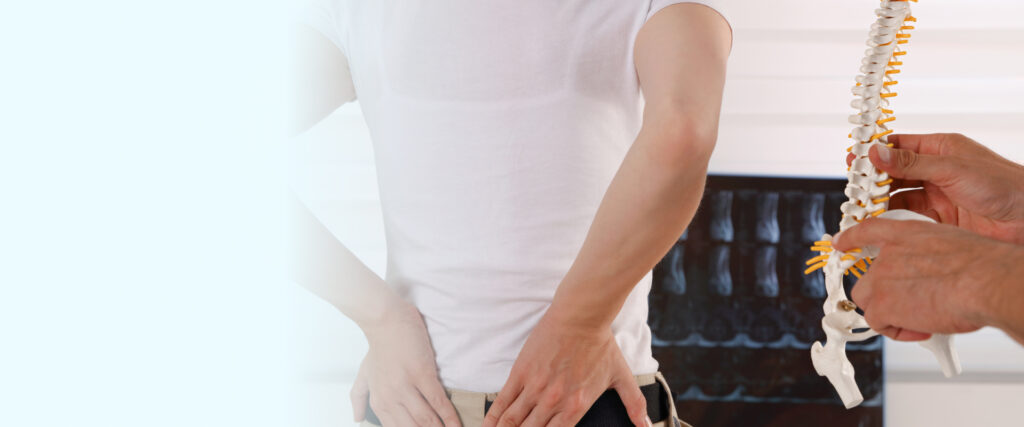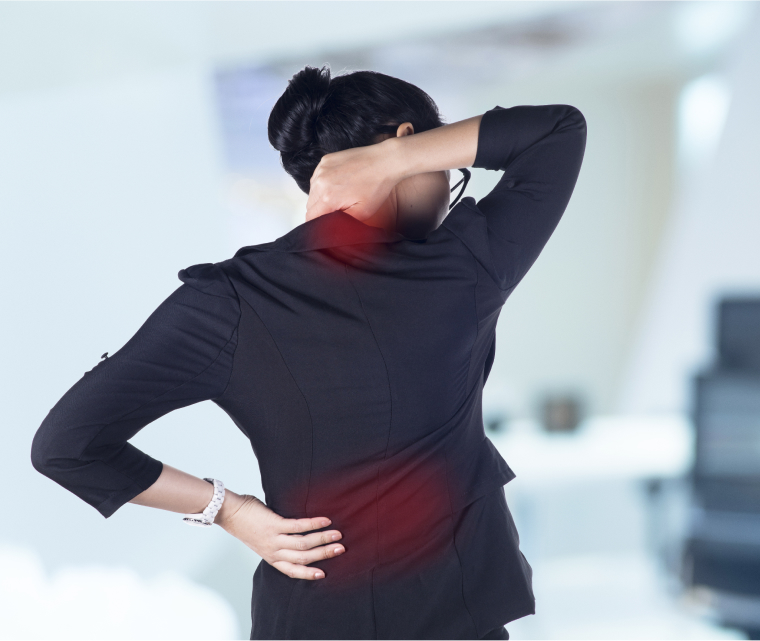
Imagine your lumbar area as a marvel of balance and movement, yet not free from troubles. You can learn about its common and uncommon origins by exploring the roots of lower back pain. This knowledge paves the way for steps to ease and avoid such discomfort, setting the stage for better spinal care.
Understanding Potential Causes of Lower Back Pain
Struggling with lower back pain? This discomfort can derail daily tasks and often leads to missed work. The lumbar region, with its bones, joints, nerves, and muscles, offers flexibility and support. However, this complexity makes it prone to pain. Pinpointing the exact cause is vital for the right lower back pain treatment, and grasping the various factors is your first move towards a more comfortable life.
Exploring Structural Causes of Lower Back Pain
Structural issues within your spine could be to blame for lower back pain. Let us look at some of them:
Herniated Discs and Sciatica
Herniated discs or sciatica might be behind your lower back pain. If the disc’s core leaks, it can press on nerves, causing big-time discomfort. Sciatica's hallmark is pain that shoots from the back to the legs, often due to nerve trouble.
You might feel sharp pain or tingling that travels down one leg. These clues help your doctor figure out the problem. Rest, medications, physical therapy, injections and surgery could be on your treatment menu.
Awareness of these issues is a step towards a broader understanding of spinal health and the slow changes that can affect the spine.

Degenerative Disc Disease and Spinal Osteoarthritis
Lower back pain might stem from degenerative disc disease or spinal osteoarthritis. As discs age, they wear down, losing height and cushioning, which can irritate nerves. Arthritis sees the slow wear of bone-protecting cartilage. This means inflamed, stiff joints and pain with limited movement in your spine.
Symptoms include a constant ache or sharp pains during certain moves. Treatments vary, with meds, anti-inflammatories, and sometimes surgery to ease nerve pressure or stabilise the spine.
Comprehending these changes is key to managing symptoms and improving your life’s quality. As the spine’s condition worsens, it hints at the issues with a shrinking spinal canal.
Spinal Stenosis Nerve Compression and Back Pain
- Lower back pain could signal spinal stenosis, where the spinal canal narrows, squeezing the cord or nerve roots.
- Pain, numbness, or weakness in the legs is common, especially when walking or standing long.
Leaning forward or sitting often helps. Treatments range from muscle-strengthening physical therapy to inflammation-easing injections. In tough cases, surgery may be needed to take the pressure off the nerves.
Knowing the ins and outs of spinal stenosis is important, but so is realising how daily habits affect spinal health.
Muscle and Ligament Strain: A Lower Back Pain Cause
Your lower back pain could come from straining muscles or ligaments. Heavy lifting or sudden, awkward moves can overstress your back. Safe lifting practices can help you avoid this:
- Squat to lift, keeping the load near you.
- Do not twist while lifting.
- Exercise to strengthen your abs and back can support your spine.
Adding these habits to your life can lower the risk of back pain. Activities like walking or swimming keep your muscles fit and flexible. Focusing on a healthy back, consider how regular workouts aid your overall health.
Lifestyle Factors and Their Impact on Lower Back Pain
Your daily life greatly affects your lower back health. Consider these lifestyle elements:
Sedentary Lifestyle
Lower back pain might stem from a sedentary lifestyle. Sitting too much can weaken your back muscles and wreck your posture, adding strain. To counter this, mix regular movement into your day. Stand, stretch, or try a standing desk to improve posture and lessen pain. Small changes, along with regular exercise, can bolster your back and protect your spine. While adjusting your activity is key, consider weight management for your back's health.
Obesity's Role in Exacerbating Lower Back Pain
Weight is a crucial factor when tackling lower back pain. Extra pounds can stress your back, worsening pain. The lumbar region, bearing your body's weight, might change under the extra load, causing pain. The shift in gravity can also tweak your posture, adding to muscle strain.
Keeping a healthy weight is vital for your back. Eating right and exercising can manage your weight and ease the stress on your lower back. This relieves spinal tension and strengthens the supporting muscles, cutting down on pain risk.
While weight management is a big step for easing back pain, remember that emotional health also plays a part in your spinal well-being.
Adopting these lifestyle aspects can help you manage and prevent back pain, boosting your overall health. These lifestyle shifts are not just about easing current pain but also about better overall well-being.
Psychological Factors Affecting Lower Back Pain
Did you know your mind might influence lower back pain?
Stress and mental health can lead to muscle tension, which might turn into chronic back pain.
Mental woes can tweak your pain perception, making it seem worse. Stress leads to pain, which increases stress- a tough cycle to break.
By tackling both the physical and emotional sides of back pain, you can shape a more complete approach to your health.
Lower Back Pain- Prevention and Management Strategies
Regular exercise is key to fend off lower back pain. Strengthening your back, core, and legs better supports your spine. Good posture, especially when seated, is also crucial for avoiding pain. If you are already dealing with back pain, work with health professionals to craft a tailored treatment plan. As you focus on these strategies, stay clued in on all the conditions that might affect your back so you are ready to handle any that come up.
Identifying Rare Causes of Lower Back Pain
While many know the usual culprits behind lower back pain, other rare but serious causes also exist. Knowing about these is critical, as they need swift and specific medical help to dodge major issues. Here are some of the rare reasons that may cause acute or chronic back pain:
Abdominal Aortic Aneurysms (AAA)
Lower back pain could mean an abdominal aortic aneurysm (AAA). This serious condition can sometimes show up as back pain.
An AAA happens when a major blood vessel grows or balloons oddly. You might feel a pulse near your navel or deep, ongoing pain in your abdomen. Back pain is a common pre-rupture sign. This pain can be mistaken for more usual back pain types, making it key to know the risks and signs of AAA.
AAA risks include older age, being male, smoking, high blood pressure, and family history. Knowing these is crucial, as a burst AAA can be fatal.
Treatment depends on the aneurysm’s size and growth rate. Small, slow-growing ones might just need regular checks. Bigger, faster-growing ones usually need surgery. Options include open surgery or a less invasive stent graft.
While AAAs are serious, remember other conditions that might not be as clear but can still affect your spine.
Also Read : Key Insights into Spinal Reconstructive Surgery
Spinal Infections and Tumors
Lower back pain might come from rare spinal infections and tumours. Pott's spine, or spinal tuberculosis, can cause major pain. Infections like this often need a long antibiotic course and sometimes surgery to fix or remove damaged bone.
Though less common, spinal tumours can also cause pain and nerve symptoms. Treatments might include surgery, radiation, or chemo, aiming to ease pain, restore function, and stop nerve damage.
After looking at specific, serious conditions like spinal infections and tumours, note that keeping your spine healthy involves medical care, daily habits, and lifestyle choices that support back health.
Enhancing Your Journey to Spinal Health
Dealing with lower back pain means combining treatment with lifestyle changes. Your spine deserves careful attention and expert care from our dedicated team. Do not let back pain limit your life. Consult your orthopaedic doctor in Chennai for personalised medical care, and start your journey to recovery. Begin your path to overcoming lower back pain with us – where a caring environment meets medical expertise.
